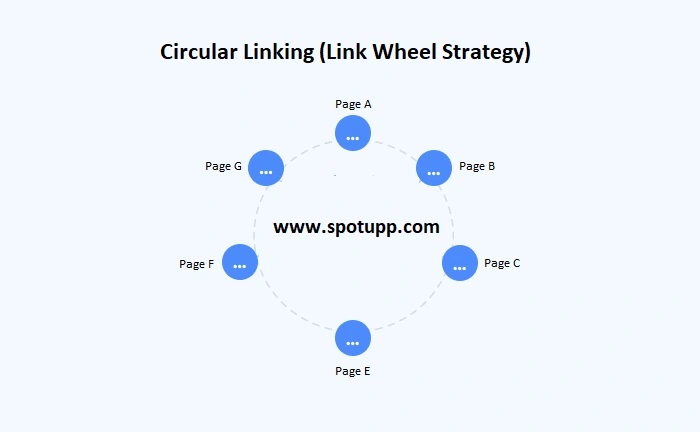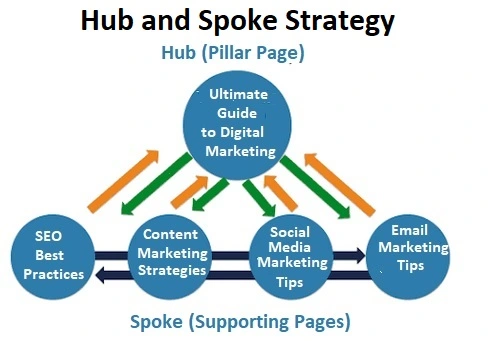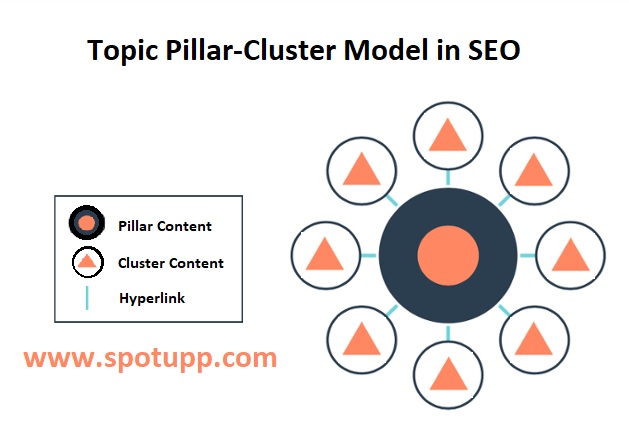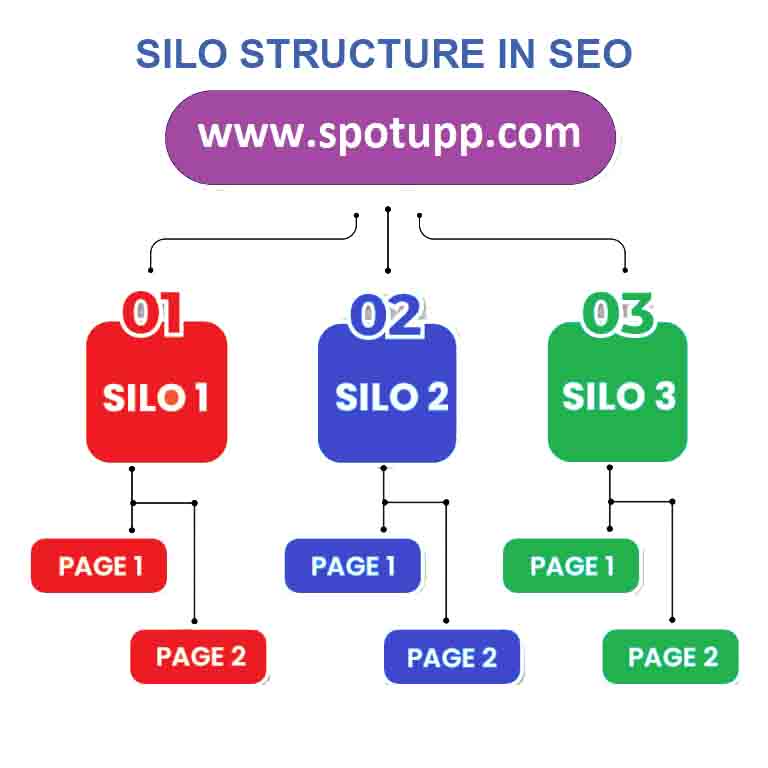Internal Page linking is a critical component of SEO for several reasons. It enhances the crawlability of a website, helps distribute link equity, improves user experience, and reinforces the topical relevance of your content. Effective internal page linking strategies ensure that search engines can efficiently navigate and index your site, ultimately leading to higher rankings and better visibility in search results.
Circular Linking (Link Wheel Strategy)

Explanation: This strategy involves creating a loop of links where each page links to the next, and the last page links back to the first.
SEO Benefit: It distributes link equity evenly across all linked pages, enhancing the overall authority and relevance of each page.
Hub and Spoke Strategy (Content Hub Strategy)
Explanation: A central “hub” page acts as a comprehensive resource on a broad topic, with “spoke” pages covering specific subtopics linked back to the hub.
SEO Benefit: It establishes topical authority, improves user navigation, and ensures efficient distribution of link equity.

Spoke-Hub Distribution (Reverse Siloing)
Explanation: Multiple related pages (spokes) link back to a central, authoritative page (hub), creating a network of interconnected content.
SEO Benefit: Enhances link equity distribution, improves crawlability, and boosts the authority of the hub page.
Topic Pillar-Cluster Model
Explanation: Similar to the Hub and Spoke strategy, this model involves a comprehensive pillar page linked to several cluster pages covering specific subtopics.
SEO Benefit: Improves topical relevance and authority, enhances user experience, and aids in better organization of content.

Related Posts/Content Recommendations
Explanation: Displaying links to related posts or articles within the body or at the end of content.
SEO Benefit: Increases user engagement by keeping visitors on your site longer and exploring more content.
Navigation Menu Links
Explanation: Including important internal links in the main navigation menu.
SEO Benefit: Enhances site-wide accessibility and ensures key pages are easily reachable by both users and search engines.
Content Series Links
Explanation: Linking a series of related articles or posts sequentially.
SEO Benefit: Encourages users to continue reading through related content, increasing engagement and time spent on the site.
Call-to-Action (CTA) Links
Explanation: Placing CTAs within content that link to relevant pages or conversion points.
SEO Benefit: Drives user actions, improves conversion rates, and guides users towards important content or services.
Silo Structure
Explanation: Organizing content into distinct categories or silos, each focusing on a specific topic.
SEO Benefit: Enhances crawlability, improves topical relevance, and provides a logical navigation path for users.

Event-Driven Links
Explanation: Linking seasonal or event-driven content to evergreen content.
SEO Benefit: Keeps evergreen content relevant and ensures seasonal traffic benefits core pages.
Authoritative Linking
Explanation: Frequently linking to high-authority pages within your site. SEO Benefit: Distributes link equity effectively and boosts the authority of important pages.
Hierarchical Structure Linking
Explanation: Organizing content in a clear hierarchy from broad topics to specific subtopics.
SEO Benefit: Improves crawlability and helps search engines understand the relationship between different pieces of content.
Contextual Linking
Explanation: Incorporating internal links naturally within the body of your content.
SEO Benefit: Enhances contextual relevance and improves user experience by guiding readers to related information.
Anchor Text Optimization
Explanation: Using descriptive and keyword-rich anchor text for internal links.
SEO Benefit: Provides context to search engines and users, improving the relevance and ranking potential of linked pages.
Relevant Content Linking
Explanation: Linking to content that is directly related to the topic being discussed.
SEO Benefit: Enhances user experience by providing additional value and keeps users engaged on your site.
Content Cluster Linking
Explanation: Similar to the pillar-cluster model, this involves linking a central content piece to several related articles.
SEO Benefit: Improves topical relevance and authority, aiding in better organization and navigation of content.
Footer and Header Linking
Explanation: Including important internal links in the footer and header sections of your website.
SEO Benefit: Ensures site-wide accessibility and enhances the visibility of key pages.
Breadcrumb Navigation
Explanation: Providing a breadcrumb trail to show users their location within the site hierarchy.
SEO Benefit: Improves user navigation, reduces bounce rates, and helps search engines understand the structure of your site.
Authority Page Linking
Explanation: Linking to high-authority pages within your site.
SEO Benefit: Distributes link equity effectively and boosts the authority of important pages.
Updated Content Linking
Explanation: Regularly updating older content with links to newer, relevant pages.
SEO Benefit: Keeps content fresh and connected to recent information, improving SEO performance.
Content Hub Creation
Explanation: Developing a central content hub that links out to multiple related articles or resources.
SEO Benefit: Establishes topical authority and provides a comprehensive resource center for users.
Sidebar Linking
Explanation: Adding links to related articles or popular posts in the sidebar.
SEO Benefit: Encourages users to explore more content on your site, increasing engagement.
Automated Internal Linking (using plugins)
Explanation: Using plugins or tools to automatically create internal links based on specific keywords or criteria.
SEO Benefit: Ensures consistent internal linking and saves time on manual link creation.
Deep Linking
Explanation: Linking to specific, detailed content deep within your site.
SEO Benefit: Improves the visibility of all your content and ensures deeper pages get indexed and ranked.
Link Consolidation
Explanation: Combining multiple internal links to direct to the same authoritative page.
SEO Benefit: Avoids link dilution and strengthens the target page’s authority.
Topical Linking
Explanation: Creating internal links based on specific topics or themes.
SEO Benefit: Reinforces topical relevance and creates a strong network of related content.
Navigational Linking
Explanation: Ensuring all primary navigation menus include links to the most important sections of your site.
SEO Benefit: Enhances user experience and ensures easy access to key content for both users and search engines.
In conclusion, mastering the art of internal page linking is a fundamental aspect of SEO that can significantly influence your website’s performance. By strategically placing internal links, you can guide both users and search engines through your content more effectively, enhancing user engagement and improving your site’s SEO metrics. Regularly auditing your internal page linking structure and staying updated with the latest SEO best practices will ensure that your website remains optimized for search engines and provides a seamless experience for your visitors. Embrace the power of internal linking to unlock the full potential of your website’s search engine performance.
Read – Internal Links: Ultimate Guide + Strategies
Optimize Your SEO with Expert Internal Page Linking
Ready to enhance your website’s SEO and user experience with expert internal page linking strategies? Contact us today to implement powerful techniques like Circular Linking, Hub and Spoke, and more. Let’s optimize your site’s structure for maximum visibility and engagement. Reach out now to start your SEO transformation!


